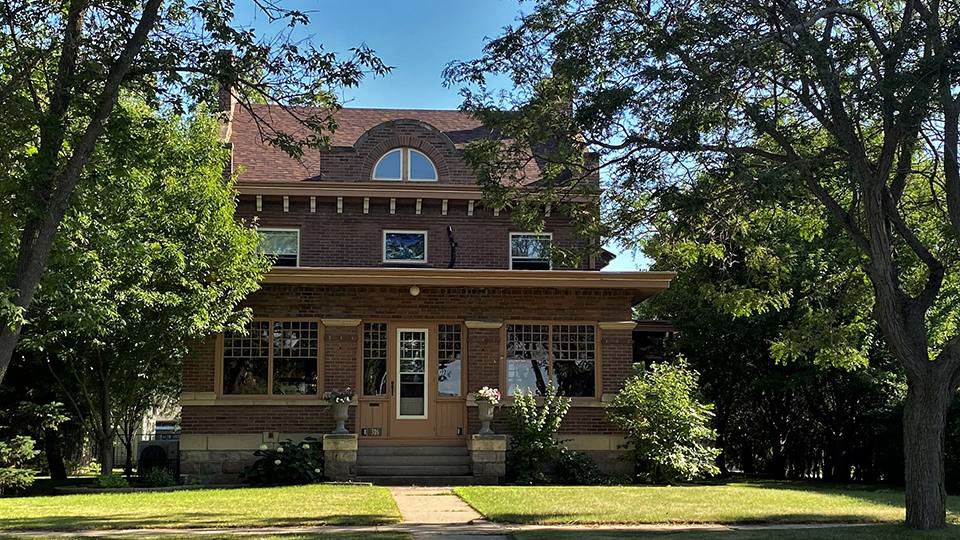Watertown City
Watertown City Hall is located at 23 2nd Street NE, Watertown, SD 57201.
Phone: 605‑882‑6200.

Photo: C.E. and Bertha Fowler House, circa 1914, located at 316 1st Avenue, SE, Watertown. Listed on the National Register of Historic Places in 2001. Photographed by wikipedia username: Jon Roanhaus own work), 2020, [cc-4.0], via Wikimedia Commons, accessed January, 2023.
Beginnings [1]
When J. C. B. Harris of Yankton arrived at Lake Kampeska in 1873, he found mile after mile of rolling prairie with the lake alone breaking the monotonous landscape. The lake had always been a landmark for the Indians who computed distances from its shores; its clear waters were sought by the red men, since few springs were to be found in the region. After returning to Yankton, Harris obtained homestead rights to land about a mile east of the lake's outlet. In 1874 James P. Werner settled at the outlet, and homestead colonies were chartered along the lake. Colonies were organized in the East "sight-unseen," and a village called Kampeska City was started; but a grasshopper invasion during the fall of 1874 destroyed the crops and the colony dissolved.
Harris returned in 1876 and found two other settlers, Ben Lovejoy and O. S. Jewell, on the west bank of the Big Sioux, where Watertown is now situated. Lovejoy had hauled rough boards, shingles and tarpaper from Marshall, Minnesota, and built the first frame house in the vicinity. The spring of 1878 witnessed an influx of home seekers as the Winona and St. Peter Railroad extended its line to the new town. The county was organized and named for Rev. G. S. Codington, a member of the Dakota Territorial legislature. A violent dispute broke out over the selection of the county seat and the railroad, wanting it at the terminus of the line, offered free transportation excursions from nearby villages. Crowds gathered to vote on the question, and Watertown was selected. After the ballots were counted, railroad officials decided to christen the town Waterville. But John and Oscar Kemp after considerable argument persuaded officials to designate the town Watertown in honor of their former home, Watertown in New York State.
Colonel Jacoby platted the town September 1, 1878. The first sign of spring in 1879 brought many newcomers to Watertown, some seeking homesteads, others business opportunities. The drug store of O. H. Tarbell was moved by oxen from its location in Kampeska City at the outlet of the lake to where the present establishment of Williamson and Tarbell stands immediately south of the First National Bank Building. During the early days a prairie fire, originating from a blacksmith forge in a shop, razed almost the entire town, which then consisted of three stores and scattered homes.
Progress in building the new town went on as rapidly as men could be obtained, 100 carpenters working at the time of the snow blockade of 1878. During this time rail transportation was at a standstill. Ten feet, six inches of snow on the level, completely covered dwellings and made travel by foot impossible. Food and fuel supplies were meager. For flour, wheat was ground by hand in coffee mills. During the extreme weather residents burned railroad ties of the extension from the town to the outlet. The trestle bridge across the river was also torn down to provide fuel.
During the next two years the town's progress was rapid. In 1884 two railway lines were added, and the first edition of the Daily Public Opinion was published in 1889.
In 1892 the Sisseton Reservation, north of Watertown, was opened for homesteading and day after day long lines of men and women stood at the door of the Land Office in Watertown to register. The opening of the reservation was a great aid to the settlement of the surrounding country, since 1,500 avid land-seekers were on hand awaiting the starter's gun at noon of April 15.
- Federal Writers' Project of the Works Progress Administration of the State of South Dakota, A South Dakota Guide, South Dakota Guide Commission, American Guide Series, State Publishing Company, Pierre SD, 1938.
